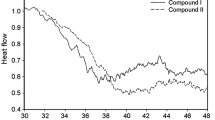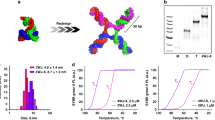Summary
Poor aqueous solubility limits the therapeutic index of paclitaxel as an anti-cancer drug. Synthesis of soluble prodrugs of paclitaxel, or conjugation of the drug to macromolecular carriers have been reported to increase its water-solubility. Macromolecular drug carriers have an added advantage of targeting the drug to the tumor site due to the abnormal tumor blood and lymphatic vasculature. This study describes a thermally responsive macromolecular carrier, elastin-like polypeptide (ELP) for the delivery of paclitaxel. Paclitaxel was bound to ELP by conjugation with the 6-maleimidocaproyl hydrazone derivative of paclitaxel, an acid-sensitive paclitaxel prodrug, for the potential treatment of breast cancer. Focused hyperthermia above a specific transition temperature at the site of a tumor causes ELP to aggregate and accumulate, thereby increasing the local concentration of the drug cargo. The paclitaxel prodrug described here bears an acid-sensitive linker that is cleavable at the lysosomal/endosomal pH, which allows a controlled intracellular release of the drug. The ELP-delivered paclitaxel in the presence of hyperthermia inhibits MCF-7 cell proliferation by stabilizing the microtubule structures, arresting the cells at the G2/M stage, and inducing apoptosis in a manner similar to conventional paclitaxel. It also inhibits proliferation of a paclitaxel resistant MCF-7 cell line. These data provide an in vitro proof of concept for the use of ELP as a delivery vehicle of paclitaxel.









Similar content being viewed by others
References
Maeda H, Seymour LW, Miyamoto Y (1992) Conjugates of anticancer agents and polymers: advantages of macromolecular therapeutics in vivo. Bioconjug Chem 3:351–362
Yamaoka T, Tabata Y, Ikada Y (1994) Distribution and tissue uptake of poly(ethylene glycol) with different molecular weights after intravenous administration to mice. J Pharm Sci 83:601–606
Kratz F (2007) DOXO-EMCH (INNO-206): the first albumin-binding prodrug of doxorubicin to enter clinical trials. Expert Opin Investig Drugs 16:855–866
Schmaljohann D (2006) Thermo- and pH-responsive polymers in drug delivery. Adv Drug Deliv Rev 58:1655–1670
Raucher D, Massodi I, Bidwell GL (2008) Thermally targeted delivery of chemotherapeutics and anti-cancer peptides by elastin-like polypeptide. Expert Opin Drug Deliv 5:353–369
Wu AM, Senter PD (2005) Arming antibodies: prospects and challenges for immunoconjugates. Nat Biotechnol 23:1137–1146
Sudimack J, Lee RJ (2000) Targeted drug delivery via the folate receptor. Adv Drug Deliv Rev 41:147–162
Laakkonen P, Zhang L, Ruoslahti E (2008) Peptide targeting of tumor lymph vessels. Ann NY Acad Sci 1131:37–43
Bidwell GL 3rd, Raucher D (2005) Application of thermally responsive polypeptides directed against c-Myc transcriptional function for cancer therapy. Mol Cancer Ther 4:1076–1085
Urry DW (1988) Entropic elastic processes in protein mechanisms. I. Elastic structure due to an inverse temperature transition and elasticity due to internal chain dynamics. J Protein Chem 7:1–34
MacEwan SR, Chilkoti A (2010) Elastin-like polypeptides: biomedical applications of tunable biopolymers. Biopolymers 94:60–77
Liu W et al (2006) Tumor accumulation, degradation and pharmacokinetics of elastin-like polypeptides in nude mice. J Control Release 116:170–178
Bidwell GL 3rd et al (2010) A thermally targeted peptide inhibitor of symmetrical dimethylation inhibits cancer-cell proliferation. Peptides 31:834–841
Massodi I, et al. (2009) Inhibition of ovarian cancer cell proliferation by a cell cycle inhibitory peptide fused to a thermally responsive polypeptide carrier. Int J Cancer 126(2):533–544. doi:10.1002/ijc.24725
Massodi I, Thomas E, Raucher D (2009) Application of thermally responsive elastin-like polypeptide fused to a lactoferrin-derived peptide for treatment of pancreatic cancer. Molecules 14:1999–2015
Liu W, et al. (2006) Tumor accumulation, degradation and pharmacokinetics of elastin-like polypeptides in nude mice. J Control Release 116(2):170–178
Weiss RB et al (1990) Hypersensitivity reactions from taxol. J Clin Oncol 8:1263–1268
Gradishar WJ (2006) Albumin-bound paclitaxel: a next-generation taxane. Expert Opin Pharmacother 7:1041–1053
Rodrigues P et al (2003) Synthesis and in vitro efficacy of acid-sensitive poly(ethylene glycol) paclitaxel conjugates. Bioorg Med Chem Lett 13:355–360
Ajaj KA, Biniossek ML, Kratz F (2009) Development of protein-binding bifunctional linkers for a new generation of dual-acting prodrugs. Bioconjug Chem 20:390–396
Rousselle C et al (2001) Enhanced delivery of doxorubicin into the brain via a peptide-vector-mediated strategy: saturation kinetics and specificity. J Pharmacol Exp Ther 296:124–131
Meyer DE, Chilkoti A (2002) Genetically encoded synthesis of protein-based polymers with precisely specified molecular weight and sequence by recursive directional ligation: examples from the elastin-like polypeptide system. Biomacromolecules 3:357–367
Daniell H et al (1997) Hyperexpression of a synthetic protein-based polymer gene. Methods Mol Biol 63:359–371
Bidwell GL 3rd et al (2007) Development of elastin-like polypeptide for thermally targeted delivery of doxorubicin. Biochem Pharmacol 73:620–631
Dreher MR et al (2003) Evaluation of an elastin-like polypeptide-doxorubicin conjugate for cancer therapy. J Control Release 91:31–43
Massodi I, Bidwell GL 3rd, Raucher D (2005) Evaluation of cell penetrating peptides fused to elastin-like polypeptide for drug delivery. J Control Release 108:396–408
Wang TH, Wang HS, Soong YK (2000) Paclitaxel-induced cell death: where the cell cycle and apoptosis come together. Cancer 88:2619–2628
Villeneuve DJ et al (2006) cDNA microarray analysis of isogenic paclitaxel- and doxorubicin-resistant breast tumor cell lines reveals distinct drug-specific genetic signatures of resistance. Breast Cancer Res Treat 96:17–39
Bidwell GL 3rd et al (2007) A thermally targeted elastin-like polypeptide-doxorubicin conjugate overcomes drug resistance. Invest New Drugs 25:313–326
Griset AP et al (2009) Expansile nanoparticles: synthesis, characterization, and in vivo efficacy of an acid-responsive polymeric drug delivery system. J Am Chem Soc 131:2469–2471
Li Y et al (2009) Novel thermo-sensitive core-shell nanoparticles for targeted paclitaxel delivery. Nanotechnology 20:065104
Torres K, Horwitz SB (1998) Mechanisms of taxol-induced cell death are concentration dependent. Cancer Res 58:3620–3626
Mansilla S, Bataller M, Portugal J (2006) Mitotic catastrophe as a consequence of chemotherapy. Anticancer Agents Med Chem 6:589–602
Massodi I et al (2010) Inhibition of ovarian cancer cell proliferation by a cell cycle inhibitory peptide fused to a thermally responsive polypeptide carrier. Int J Cancer 126:533–544
Brigger I, Dubernet C, Couvreur P (2002) Nanoparticles in cancer therapy and diagnosis. Adv Drug Deliv Rev 54:631–651
Guo B et al (2003) Potent killing of paclitaxel- and doxorubicin-resistant breast cancer cells by calphostin C accompanied by cytoplasmic vacuolization. Breast Cancer Res Treat 82:125–141
Orr GA et al (2003) Mechanisms of taxol resistance related to microtubules. Oncogene 22:7280–7295
Ambudkar SV et al (1999) Biochemical, cellular, and pharmacological aspects of the multidrug transporter. Annu Rev Pharmacol Toxicol 39:361–398
Acknowledgements
This research was supported by grants from the National Science Foundation (CBET-0931041) and the National Institute of Health (R43 CA135799-01A2). We thank Ms. Rowshan Begum for purification of the proteins used in the study, and Dr. Gene L. Bidwell III and Ms. Emily H. Thomas for helpful discussion.
Conflict of interest:
None
Author information
Authors and Affiliations
Corresponding author
Rights and permissions
About this article
Cite this article
Moktan, S., Ryppa, C., Kratz, F. et al. A thermally responsive biopolymer conjugated to an acid-sensitive derivative of paclitaxel stabilizes microtubules, arrests cell cycle, and induces apoptosis. Invest New Drugs 30, 236–248 (2012). https://doi.org/10.1007/s10637-010-9560-x
Received:
Accepted:
Published:
Issue Date:
DOI: https://doi.org/10.1007/s10637-010-9560-x




